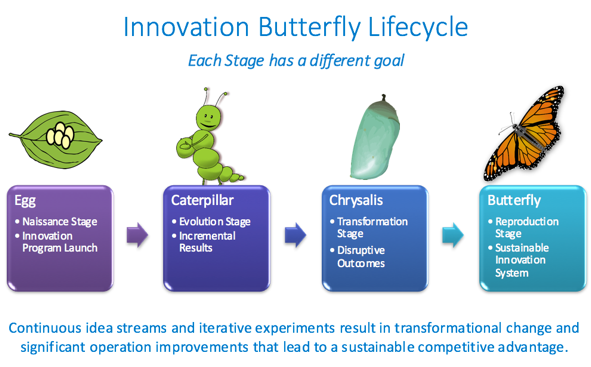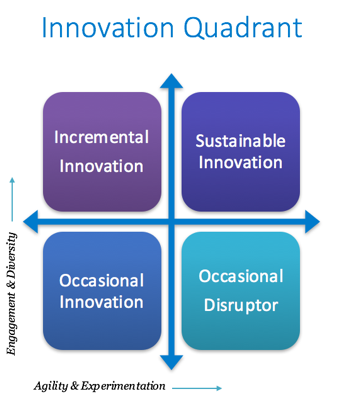It sure feels like big companies are trying to transform in a hurry from a gigantic 10,000 lb. elephant to a measly 0.3 g butterfly. Even a great magician would be hard pressed to pull off such a great feat, but big companies are working hard at doing just that. New collaborative ecosystems, innovation centers and leading-edge technologies are helping startups thrive in a much more open environment to constantly disrupt businesses in a range of industries. Small business failure rates are declining as those for bigger companies head in the opposite direction.

The challenge for big companies that launch their business transformation program is that it is not a simple three-step program. The classic crawl, walk and run model just does not work when it comes to innovation. As organizations look to operationalize their innovation processes there is one key missing element. The challenge is not only to transform the business but also to create a mindset that allows the company to repeat its success and sustain this transformation.
Organizations cannot rest on their laurels with the ever-shrinking lifespan of new products and services in the marketplace. The lifespan of butterflies is on average just one month. Companies can learn a lot from applying the butterfly life cycle (see diagram below) to their business whether for planning and executing discreet experiments to learn and fail fast or to build an engine that continually leads to new innovations.

Many organizations seem receptive to running an innovation activity for a defined period of time. They organize competitions, hackathons and other catchy innovation session themes to engage their people and hopefully allow teams to propose creative suggestions or ideas that have the potential to become winning projects. With the best of intentions in mind, such occasional activities can be useful; but the real value rests in developing a comprehensive innovation management strategy that allows for continuous transformation.
This innovation quadrant (see diagram below) is a good depiction of how different organizations approach innovation.

Companies can be categorized into four distinct segments:
- The “Occasional Innovators” segment represents the highest number of midsize companies that have built a good niche and are operating in a lower-margin business that has not yet attracted too many disruptive competitors.
- The “Incremental Innovators” are larger companies with a more established business. They have the most to lose from new entrants vying for their clients but tend to view innovation as a necessary evil; it is often something they take on too late and generally only when they are faced with threats to their survival.
- The “Occasional Disruptor” segment is best described as the “one-hit” wonders that take a particular market by storm but tend to just as quickly get lost in the shuffle since they have no second act.
- The “Sustainable Innovators” are a unique breed; Apple and Google are the usual names that quickly come to mind. These organizations have mastered the innovation butterfly.
Included in the quadrant are “Engagement and Diversity” as well as “Agility and Experimentation.” These are the key variables that ultimately determine where each company will find itself on this quadrant:
- Engagement and Diversity is the combination of making innovation a collaborative effort by everyone in the organization and leveraging diversity as a true competitive advantage to ensure a much more predictable supply of creative ideas.
- Agility and Experimentation is the combination of trying small initiatives and losing fast and wisely as the organization constantly tries to be the first in the marketplace to find new winning business models and offerings.
Best practice recommendations
Here are five best practice recommendations that can help propel your organization to the coveted top left-hand corner of the innovation quadrant:
- Include innovation as part of your core corporate strategy and make it an enterprise-wide and cross-functional mandate.
- Promote innovation and recognize teams through planned events that are organized and systemized as any other standard operating procedure in your organization.
- Reward experimentation and learning by defining the right growth metrics that lead to results in your industry and for your business.
- Make any collaboration purposeful by including a path to innovation activity – these are the most impactful conversations everyone in your organization should be having.
- Baseline the expected value from your creative ideas and set checkpoints to compare the financial impact of your winning projects. This feedback loop is critical for learning from your mistakes and celebrating your wins as you institute a continuous business transformation state of mind.
Larger businesses should be an elephant and a butterfly, as strong as one and as free and effortless as the other. Companies should heed Ginni Rometty’s advice: “The only way you survive is you continuously transform into something else. It’s this idea of continuous transformation that makes you an innovation company.”
Which innovation quadrant best represents how your organization has organized its innovation strategy and objectives?
Ludwig Melik is CEO and founder of Planbox, a pioneering provider of cloud-based agile work innovation software solutions – from creative ideas to winning projects. We help organizations thrive by transforming the culture of agile work, continuous innovation and creativity across the entire organization. Products include collaborative innovation management, team decision making, and work management applications. Email Ludwig at ludwig.melik@planbox.com.
